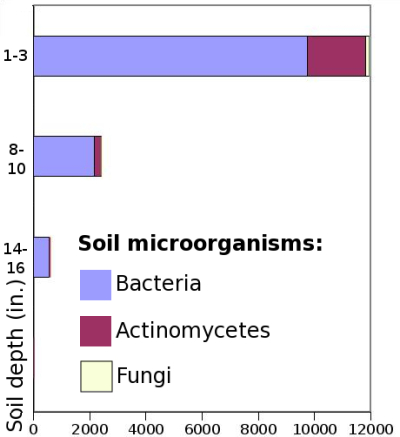
Disadvantages of tilling and bare soil
 I've been dabbling in no-till techniques for
the last few years, due to a vague understanding that tilling is bad
for the soil. Robert Kourik's book gave me the low down on the
best no-till techniques and why they succeed (or fail.)
I've been dabbling in no-till techniques for
the last few years, due to a vague understanding that tilling is bad
for the soil. Robert Kourik's book gave me the low down on the
best no-till techniques and why they succeed (or fail.)
So, what's wrong with
tilling? Although we can't see it, our soil is teeming with
microscopic and macroscopic life, most of which lives in the top three
inches of soil. Tilling churns up soil, mixing the microorganism
playground with the lower soil and resulting in a lot less life.
Although you might expect that the microorganisms folded deeper into
the earth just expand their populations, lack of air and sun quickly
kills them off.
Bare soil is another
bane of conventional tilling. Erosion is the obvious problem ---
rain washes away the precious topsoil when it is unprotected by plants
or mulch. But sun is just as much of a problem. When bare
soil is exposed to summer sun, the heat vaporizes nitrogen and kills
the precious soil microorganisms, resulting in a garden that requires
much more fertilizer in order to grow your veggies.
Of course, we can't just
throw our lettuce seeds amid the grass in our lawns and expect it to
grow. So how do we garden without annual tilling and bare soil?
This post is part of our lunchtime series reviewing Robert Kourik's Designing and Maintaining your
Edible Landscape Naturally.
Read all of the entries:
|
Want more in-depth information? Browse through our books.
Or explore more posts by date or by subject.
About us: Anna Hess and Mark Hamilton spent over a decade living self-sufficiently in the mountains of Virginia before moving north to start over from scratch in the foothills of Ohio. They've experimented with permaculture, no-till gardening, trailersteading, home-based microbusinesses and much more, writing about their adventures in both blogs and books.
Want to be notified when new comments are posted on this page? Click on the RSS button after you add a comment to subscribe to the comment feed, or simply check the box beside "email replies to me" while writing your comment.
- Remove comment
- Remove comment
